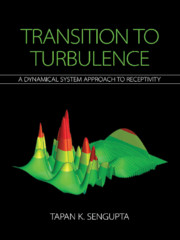Book contents
- Frontmatter
- Dedication
- Contents
- Preface
- 1 Receptivity, Instability, and Transition: A Perspective
- 2 Dynamical System Theory and Role of Equilibrium Flows
- 3 Fundamentals of Scientific Computing
- 4 Instability and Transition
- 5 Receptivity Analysis: Relation with Instability Experiments
- 6 Dynamical System Theory of Linear Receptivity
- 7 Nonlinear, Nonparallel Effects on Receptivity, Instability, and Transition
- 8 Three-Dimensional Routes of Transition to Turbulence
- 9 Receptivity to Free Stream Excitation: Theory, Computations, and Experiments
- 10 Nonlinear Receptivity Theories: Hopf Bifurcations and Proper Orthogonal Decomposition for Instability Studies
- 11 Mixed Convection Flow
- 12 Baroclinic Instability: Rayleigh–Taylor Instability
- 13 Coherent Structure Tracking in Transitional and Turbulent Flows
- 14 The Route of Transition to Turbulence: Solution of Global Nonlinear Navier–Stokes Equation
- References
11 - Mixed Convection Flow
Published online by Cambridge University Press: 16 February 2021
- Frontmatter
- Dedication
- Contents
- Preface
- 1 Receptivity, Instability, and Transition: A Perspective
- 2 Dynamical System Theory and Role of Equilibrium Flows
- 3 Fundamentals of Scientific Computing
- 4 Instability and Transition
- 5 Receptivity Analysis: Relation with Instability Experiments
- 6 Dynamical System Theory of Linear Receptivity
- 7 Nonlinear, Nonparallel Effects on Receptivity, Instability, and Transition
- 8 Three-Dimensional Routes of Transition to Turbulence
- 9 Receptivity to Free Stream Excitation: Theory, Computations, and Experiments
- 10 Nonlinear Receptivity Theories: Hopf Bifurcations and Proper Orthogonal Decomposition for Instability Studies
- 11 Mixed Convection Flow
- 12 Baroclinic Instability: Rayleigh–Taylor Instability
- 13 Coherent Structure Tracking in Transitional and Turbulent Flows
- 14 The Route of Transition to Turbulence: Solution of Global Nonlinear Navier–Stokes Equation
- References
Summary
Instability of Mixed Convection Flows
At this point it would be relevant to examine heat transfer effects for incompressible fluid flows governed by the Navier–Stokes equation, along with the mass conservation equation. Any reckoning of heat transfer, demands consideration of energy conservation, taking into account possible heat transfer in the flow, originating from the boundary and initial conditions. In forced convection, the flow is caused by an external agency, such as by a fan, a pump or by atmospheric wind. In contrast, free convection is caused by buoyancy force that exists only in the fluid. Mixed convection flow is a combination of free or natural convection (without any background flow of the medium) and forced convection [496], and in the present context, the examination about very low speed flow, with heat transfer taking place because of a small temperature gradient. Such heat transfer can be modeled by Boussinesq approximation. This approximation is limited however to small temperature gradients.
For the small temperature gradients that are responsible for heat transfer effects from the boundaries, it is to be investigated how the associated buoyancy force comes into play. This can be attempted through the Boussinesq approximation, on the premise that the buoyancy force is the result of change in density. Otherwise, the density is treated as constant, as representative of a reference temperature (call it T0), and the temperature differential as δT = (T − T0). The buoyancy force is then inserted in the momentum equation, in an appropriate direction, given by δρg in the direction of gravity (say, along the y- axis). Introducing the volumetric expansion coefficient as, the buoyancy force is given by. As further explained in the next section, the reason is that there is an added variable to deal with for the mixed convection flows. And, energy equation is intrinsic to all study of flows that involve heat transfer. Thus, study of corresponding perturbation fields would require consideration of entropic disturbances.
Mixed convection flows are found in many natural and engineering devices, as in geophysical fluid dynamics and various engineering applications that are affected by mixed convection flow instabilities. Studies of these flows in the presence of different disturbance sources are important. It has been shown [412, 420] that vortical excitation of small amplitude can couple to create thermal fluctuations, implying possible flow control in many engineering devices.
- Type
- Chapter
- Information
- Transition to TurbulenceA Dynamical System Approach to Receptivity, pp. 399 - 458Publisher: Cambridge University PressPrint publication year: 2021



